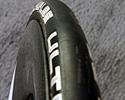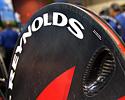

|

|
 |

|

|

|

|
 |
 |

|
 |
 |
 |
Interbike show
Las Vegas, Nevada, USA, September 22-26, 2008
Main Page Previous Part Next Part
Part 13 - October 3, 2008: Carbon hoops from the Sands Convention Center
By James Huang
HED continues the 'wider is better' march

|
Aerodynamics guru Steve Hed set forth on an interesting path with the 23mm-wide C2 rim extrusion introduced on his Ardennes aluminum clincher. According to Hed, the broader base provides better tire support for improved traction and is also more aerodynamic, especially at greater yaw angles.
While it seems counterintuitive that a wider rim would be more aerodynamic than a narrower one, Hed insists that it's the key to making faster wheels, especially in crosswinds. For 2009, the concept has now been expanded across nearly the entire wheel range, clinchers and tubulars included. In fact, carbon tubulars even go one step further: rim width at the tire well is 23mm but the new bulged cross-section now measures a whopping 28mm at its broadest point.
Moreover, tubular tire wells now measure roughly twice as deep as before, thus supposedly delivering the same improvements in handling and road feel that the C2 rim did for clinchers.
Normally we'd be skeptical of such claims but after riding the Ardennes for ourselves, we can't help but give HED the benefit of the doubt for now. At the very least, the broader rims and deeper tubular tire beds should be of particular interest to 'cross riders.
HED also introduces a new Flamme Rouge line for those who have to have the latest and greatest. The new hubset uses aluminum flanges bonded to a carbon center tube that shaves 15g per pair and ceramic bearings will come standard.
Steve Hed has been busy on the aero bar front as well with a new integrated model called Black Dog. Claimed weight is just 600g complete, aided by the integrated carbon brake levers (with carbon return springs no less) and carbon construction for the base bar and extensions.
Proper fit on the Black Dog was a key priority: HED will offer three base bars in both flat and drop styles three different extensions and two different armrest mounts, all with nearly countless available permutations of width, length, tilt and rotation.
Expanded wheel range for Reynolds Cycling

|
Reynolds Cycling's top-end DV and MV wheels go on a serious diet for 2009 courtesy of an upgrade to high-modulus fibers and a new DT Swiss 240s 'hybrid' hubset that borrows the lighter axles, freehub bodies and star ratchets for the higher-end 190 line.
Moreover, Reynolds claims the new UL construction is better at dissipating heat generated from braking than earlier rims and revamped lay-up schedules yield a smoother ride.
As compared to last year's DV 46 UL, the new DV 46T UL is down from 1200g per pair to just 1040g and a new UL clincher version (last year's was tubular-only) adds another 205g. The versatile MV line also gets the UL treatment for 2009: the MV 32T UL's claimed weight is now bang on at 1000g while the clincher version is an excellent 1325g per set.
Last year's non-UL DV wheels are effectively replaced by a new 3K line which trades in the unidirectional finish for a glossy woven top sheet. The rims are therefore a bit heavier than those of the UL line and the 3K wheels will also use standard DT Swiss 240s hubs instead of the UL's hybrid models. Even so, total weights are still highly competitive at 1245g per pair for the tubular version and 1500g for the clinchers.
Naturally, the 3K wheels will also be a bit less expensive. While the new DV 46 UL wheels will fetch US$2750 and US$2400 for the clincher and tubular versions, respectively, the 3K counterparts will have retail costs of US$2500 and US$2300.
Also new from Reynolds for 2009 is a clincher version of its Element disc (US$1600; 1340g) and a more value-oriented Strike carbon clincher (US$1575; 1690g) with 66mm-deep rims to complement the existing 46mm-deep Assault and 32mm-deep Attack.
For the off-road crowd, the MTN C (previously known as the Topo C) now weighs just 1385g per pair (a loss of 114g) and a revised rim shape makes for easier conversion to tubeless. A new aluminum model called Canyon will join the lineup for 2009 as well.
And what about the venerable fork line? Reynolds actually didn't display any forks at all, saying they were currently being redesigned to meet new stricter CEN testing standards. The new models are slated to hit the market in about 90 days or so but the once-comprehensive range will be reduced to only a lightweight road model and a cyclo-cross fork, both with straight, non-tapered steerer tubes and semi-integrated crowns similar to the now-defunct UL.
Easton ups its wheel game

|
Easton's wheel line has been steadily building momentum what with their superb build quality and well-designed components. The biggest change for 2009 is the new R4SL hubset used on the EA90 SLX, EC90 SLX and EC90 Aero road wheels.
A slimmed-down rear axle, new aluminum axle end cap and aggressively machined group-specific freehub bodies help shave 36g from last year's R4 hubs and Grade 3 hybrid ceramic bearings now come standard. The EA90 SLX also gets new EA6X alloy rims which save an additional 61g per pair, thus bringing the total claimed weight down to just 1395g with the new hubset. Claimed weight on the updated EC90 Aero and EC90 SLX is now 1335g and 1175g, respectively.
On the trail front, the XC One hubs lose a few grams courtesy of more aggressive machining, an adjustable bearing setup similar to last year's R4 road hubs, and new lip seals. The beefier Havoc gets a new bolt-on rear axle option while the front hub gets a 15mm thru-axle adapter.
Not much has changed on the Easton carbon fork front save for one exceptionally clever little detail called Internal Thread Technology. In the place of the usual compression plug system is a full-length internal thread formed out of lightweight foam epoxy.
While the fork itself is a little heavier as a result, the plug is lighter so it's mostly a wash; forks with shorter steerers supposedly actually lose a few grams. Moreover, Easton says the new setup is more crush-resistant than before and is undoubtedly easier to use.
Photography
For a thumbnail gallery of these images, click here
Images by James Huang/Cyclingnews.com
- HED's new tubular rims sport a completely new profile that is 23mm wide at the tire well and a gargantuan 28mm at their broadest point. According to HED, this makes the rims far more aerodynamic, especially in crosswinds.
- Tire well depths have also increased by roughly two times, thus providing more sidewall support for better handling, especially with wider 'cross tires.
- Even with the new oversized rim dimensions, the new Scorpio FR still only weighs 1157g per pair.
- New Flamme Rouge-edition hubs use carbon center sections and ceramic bearings.
- Disc wheels sport a complex sidewall curvature and PowerTap hubs are available as an option.
- Um…
- HED introduced the wide rim concept on the Ardennes last year…
- …and there's now a track edition available.
- HED also showed off the new Black Dog integrated aero bar, claimed to weigh just 660g.
- The modular design allows for a wide range of adjustability.
- Integrated carbon brake levers help keep the weight down.
- Steve Hed isn't sure what to call this widget just yet but imagines it might be useful for triathletes who are just coming out of the water and need to apply some sunblock or suck down a few electrolyte tablets.
- Reynolds revamps its DV 46 range to make them substantially lighter than the '08 versions.
- The striking Element disc wheel is now offered in a clincher.
- Riders hoping to save a bit of cash or get a different look can opt for the new 3K series of wheels.
- The new Strike uses the same hubs as the Attack and Assault but pairs them with a more aerodynamic 66mm-deep carbon clincher rim.
- The new Canyon mountain bike wheel uses an aluminum rim.
- The six-bolt disc hubs use cartridge bearings and an alloy freehub body.
- As always, Reynolds offers its wheels with a wide range of hub options that include track…
- …PowerTap…
- …and even Lefty for use with Cannondale forks.
- Easton upgrades its EA90 SLX, EC90 SLX and EC90 Aero with lighter R4SL hubs for 2009.
- Group-specific freehub bodies shave as many grams as possible when using Shimano 10-speed, SRAM Red or Campagnolo cassettes.
- The EA90 SLX arguably wins the 'Most Improved' category with the new R4SL hubs and lighter EA6X rim extrusions. Total weight is now down to just 1395g.
- The EC90 SLX also gets the new R4SL hubs which bring the weight down to 1175g per pair.
- Easton XC One upgrades include a new R4-like hubset with adjustable bearing preload.
- More aggressive machining shaves a few grams.
- Easton's carbon fiber forks get an exceptionally clever Internal Thread Technology which replaces the conventional compression plug with a trick set of internal threads made from foam epoxy.